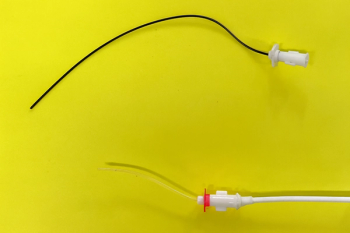
Anemia of chronic kidney disease (Proceedings)
Anemia is a common abnormality noted in patients with CKD, affecting 32 to 65 per cent of cats with CKD.
Incidence and impact
Anemia is a common abnormality noted in patients with CKD, affecting 32 to 65 per cent of cats with CKD. Treating anemia has many benefits. In people, treatment of anemia improves cognitive function, decreasing depression and increasing quality of life. Treatment of anemia may slow the progression of renal disease in human beings.
Causes of anemia of CKD
The basic mechanisms of anemia include blood loss, red blood cell destructive processes, and failure of bone marrow production.
Blood loss anemia
Blood loss can occur for a variety of reasons in the animal with renal failure, including iatrogenic blood loss anemia from frequent blood sampling for diagnostic testing, gastrointestinal loss, ecto- or endoparasitism, and increased bleeding secondary to uremic platelet function defect.
In human beings with chronic renal failure, gastric ulceration and necrosis are common findings. Clinical experience with animals in renal failure suggests that significant gastrointestinal bleeding occurs in certain individuals. Factors that can contribute to gastrointestinal bleeding in patients with renal failure include increased gastrin levels from decreased renal clearance, concurrent use of non-steroidal anti-inflammatory medications or corticosteroids. Clinical signs of upper gastrointestinal bleeding include hematemesis, melena, or hematochezia. Melena is not always seen in animals with chronic gastrointestinal blood loss since loss can occur in relatively small quantities over time. Other indicators include an elevated BUN/creatinine ratio and microcytic, hypochromic anemia when chronic loss has caused iron deficiency.
The chief hemostatic change that occurs with uremia is impaired platelet function. Total platelet count in animals with renal failure is usually within or slightly below reference range unless the disease etiology causing renal failure also results in thrombocytopenia (e.g. leptospirosis). This thrombocytopathy increases the risk of bleeding.
Red cell destruction
The uremic environment decreases red blood cell survival in some people, but dogs with renal failure had no evidence of increased RBC fragility.
Decreased erythropoiesis
Decreased bone marrow production may result from uremic toxins that inhibit erythropoiesis, nutritional deficiencies (e.g., B vitamins), bone marrow fibrosis, and concurrent inflammation, although the main reason is a deficiency of erythropoietin.
Erythropoietin (EPO) is the hematopoietic growth factor that stimulates erythrogenesis in anemia, and deficiency is the most commonly recognized contributor to anemia of chronic renal failure. Most EPO is produced in the peritubular interstitial cells of the outer medulla and inner cortex of the kidney; however between 10 and 15% of total EPO is produced by the liver. Renal hypoxemia caused either by anemia or hypoxia is the main trigger for EPO production, and the main effect of EPO to stimulate red blood cell growth and differentiation is on the colony-forming erythroid cell (CFU-E) of the bone marrow. Following an increase of EPO production, approximately 5 days time is required for the release of erythrocytes into circulation. Additional effects of EPO that are beneficial in the anemic patient include induction of hemoglobin and red blood cell (RBC) membrane protein synthesis, and facilitation of release of RBC from the bone marrow to the bloodstream. With chronic kidney disease and reduced renal mass, renal EPO production is attenuated which causes relative EPO deficiency. In anemic dogs with CKD, measured EPO can be above normal, but is not as elevated as in dogs with similarly severe anemia that are not uremic. Cats with CKD have EPO levels that are similar to normal cats.
Other factors contributing to decreased erythropoiesis include B vitamin deficiency. B vitamins, particularly B12 (cobalamin), folic acid, niacin, B2 (riboflavin), and B6 (pyridoxine) are all important in erythropoiesis. Although deficiencies have been documented in people with chronic renal failure, evaluation of B vitamin concentrations has not been reported in dogs or cats with chronic renal failure. A variety of possible uremic toxins have been identified in people, and some of these toxins may contribute to poor regenerative response of the bone marrow. The effects of these substances have not been investigated in dogs and cats.
Iron deficiency can be caused by chronic blood loss, and poor iron intake in renal failure. Iron-deficiency anemia must be differentiated from anemia of chronic inflammatory disease that also causes a nonregenerative anemia. The distinction between these etiologies is important to determine therapy; while iron deficiency anemia would be expected to respond to supplemental iron therapy, anemia of chronic inflammatory disease will persist with iron therapy and iron overdose can result.
Signs and diagnosis
Anemia is a common abnormality in patients with chronic renal failure. It causes many signs, including exercise intolerance, fatigue, weakness, anorexia, pallor, bounding or weakly palpable pulses, tachypnea, tachycardia, heart murmur and congestive heart failure. Presence of hematemesis, melena, hematochezia suggests gastrointestinal bleeding
Complete blood count in the anemic renal failure patient should reveal normocytic, normochromic, nonregenerative anemia. White blood cell count, differential, and platelet count are not affected. Abnormalities in these cell lines should be evaluated as separate problems. Microcytosis and hypochromasia would be seen in animals with chronic iron deficiency. Red blood cell deformities (echinocytes, burr cells) can occur in uremic patients.
Although erythropoietin deficiency is the most likely explanation for nonregenerative anemia with chronic renal failure, erythropoietin assay is not currently available.
Treatment
Transfusion
Blood transfusion is an appropriate therapy if the anemia is causing clinical signs that need rapid correction, particularly dyspnea or heart failure. The availability of blood for transfusion is limited in some practices and there may be a short delay before the blood product is available for transfusion. The transfused cells will have a shortened lifespan due to the uremic environment and due to minor incompatibility reactions. If frequent transfusions are necessary, cross-match incompatibility can become a limiting factor and it is usually not possible to restore the RBC mass to normal due to volume limitations.
Erythropoiesis stimulating agents
Human erythropoietin has been produced using recombinant DNA technology. Recombinant human erythropoietin (r-HuEPO) has approximately 80% amino acid sequence identity to canine and feline erythropoietin. The functional site is similar enough to have biologic activity in the bone marrow. Epoetin (Epogen®, Procrit®) and darbepoetin (Aranesp®) have been used successfully for treatment of anemia of CKD in human beings, cats, and dogs.
The decision to treat anemia is based on a variety of factors. Cats can adapt to slowly developing anemia and may exhibit minimal clinical signs. The risks associated with the available treatment options always must be weighed against the benefit of diminishing the anemia. Because 50 to 70 per cent of cats treated with Epoetin develop adverse events (unpublished data, Langston and Kittrell, 2006), treatment is recommended only if clinical signs are present. Therapy is reserved for patients with moderate to severe anemia that is not attributable to transient causes of anemia (e.g., bleeding from gastric ulceration). rHuEPO and darbepoetin are not licensed for use in dogs or cats, and owners should provide informed consent prior to administration. Because the risk of adverse reactions seems lower with darbepoetin, I no longer use epoetin.
The recommended starting dose for darbepoetin for people is 0.45 µg/kg SQ or IV once weekly. The dose can be decreased to every second week once the hematocrit has reached the low end of the target range (dogs 30-35% PCV, cats 25-30% PCV). Few patients are able to maintain the target hematocrit with administration every three weeks. In the author's experience, most pets started at 0.45 µg/kg required a dose increase, and now I routinely start at 1 µg/kg. For patients being converted from rHuEPO therapy, 200 U of rHuEPO is equivalent to 1 µg of darbepoetin. Some clinicians have adopted a set dose of 6.25 µg per cat once weekly, regardless of body weight. Hematocrit generally starts to increase within 1 to 2 weeks of starting ESA therapy. The desired PCV typically takes 4 to 12 weeks to achieve.
Iron
Iron, a major component of hemoglobin, should be supplemented in all patients receiving erythropoiesis stimulating agents. Ferrous sulfate, a commonly available form, is dosed at 100-300 mg per day for dogs, which corresponds to 20-60 mg of elemental iron. For cats, 50-100 mg per day of ferrous sulfate (10-20 mg elemental iron) is recommended. Gastrointestinal upset is a common problem with oral iron supplements.
Despite iron administration, iron indices in people do not rise during initial rHuEPO therapy, indicating that large amounts of iron are being utilized. In dogs, iron indices actually decreased, despite oral iron supplementation. Although oral iron is inexpensive, it is poorly absorbed and gastrointestinal side effects limit compliance in people. Intramuscular iron dextran injections may be a practical therapy. The dose is 10-20 mg/kg for dogs, 50 mg total dose per cat, once monthly. There is a risk of anaphylaxis if iron dextran is administered intravenously.
Other treatments
Supplementation of B vitamins necessary for erythropoiesis may be beneficial in CKD patients but will have little effect on restoring RBC mass. Anabolic steroids have been recommended for the treatment of the anemia of CKD. Results have been variable and generally disappointing. Their use cannot be recommended due to the lack of efficacy and the potential for hepatotoxicity. Gastrointestinal blood loss secondary to uremic gastropathy can be minimized by resolving the uremic crisis and providing gastroprotective drugs. Gastroprotective treatments to consider include histamine-2 receptor antagonist such as famotidine (0.5mg/kg PO, IM, IV, SID) or ranitidine (1 mg/kg PO, IM, IV, BID), locally acting gastric protectants such as sucralfate (0.25-1 gram PO TID), or proton pump inhibitors such as omeprazole (0.5-1 mg/kg PO SID). These doses reflect a dose reduction for renally excreted drugs such as histamine-2 receptor antagonists. Resolution of anemia and improvement of the BUN: creatinine ratio would be evidence of response to treatment.
Monitoring treatment
The PCV or hematocrit and a reticulocyte count should be checked weekly until the PCV has been stable for 4 weeks on biweekly therapy with darbepoetin. Monthly monitoring is usually sufficient once the PCV has been stabilized. A complete blood count should be checked monthly to bimonthly for the duration of therapy. Blood pressure should be evaluated prior to therapy and at each visit after starting therapy.
Monitoring iron parameters is recommended prior to and one month after starting erythropoietin therapy and then monthly to bimonthly thereafter. Serum iron level is a measure of mobile iron. Total iron binding capacity (TIBC) is an indirect measure of transferrin, the carrier molecule for iron in the serum. Ferritin is a water-soluble storage form of iron that is present in the cell cytoplasm and in the circulation. Hemosiderin is a storage form that is present in the bone marrow and can be estimated by evaluating bone marrow cytology when necessary. The transferrin saturation is a measure of the amount of the iron carrier molecule, transferrin, that is bound to iron, and is calculated from the equation:
% saturation = serum iron ÷ TIBC.
Transferrin saturation is normally above 33%. With iron deficiency, the serum iron level, ferritin level, and the transferrin saturation are low. However, in the anemia of chronic inflammation, iron is sequestered in the body, causing iron levels to be low, but ferritin levels are elevated.
The mean hemoglobin content of reticulocytes (CHr) is a measure of iron status in human beings that is more sensitive than other methods. It may prove to be a reliable early indicator in veterinary medicine, but limited data are available as yet.
Complications of treatment
Hypertension has been associated with erythropoietin therapy, although not directly caused by it. Increases in blood pressure developed in 40 to 50 per cent of cats and dogs treated with EPO, and the author's clinical experience corroborates this observation. Blood pressure should be checked prior to starting therapy and monthly to bimonthly thereafter. Antihypertensive medications may need to be started or doses escalated in patients already being treated for hypertension. Seizures have been reported in association with erythropoietin administration and hypertension may play a role in their etiology.
Injection discomfort or skin reactions reported in people are not commonly recognized in animal patients. Vomiting has been reported but it is difficult to differentiate whether it is related to erythropoietin usage or the underlying uremia. Polycythemia is certainly possible if the dose is excessive and not adjusted appropriately.
Refractory anemia in patients on rHuEPO therapy has many potential causes. A careful review of the patient and the clinical pathology results may indicate iron deficiency, ongoing blood loss, or anemia of chronic inflammatory disease. More than 75 per cent of human patients who fail to respond to rHuEPO have underlying infection or inflammation. In a retrospective study of cats, 25 per cent of patients did not reach the target hematocrit and were suspected of having infection or inflammation (unpublished data, Langston and Kittrell, 2006). Higher doses of rHuEPO do not overcome the resistance; control of the infection or inflammatory state is necessary. Refractory anemia may represent formation of anti-rHuEPO antibodies causing PRCA.
PRCA
Human recombinant DNA erythropoietin is not antigenically identical to canine or feline erythropoietin. Antibodies to rHuEPO developed in 63 to 100 per cent of healthy dogs receiving rHuEPO, and 22 to 100 per cent developed a concurrent anemia. In cats and dogs with naturally occurring CKD treated with rHuEPO, five of seven cats treated for more than 180 days, and two of three dogs treated for more than 90 days, developed refractory anemia attributed to anti-rHuEPO antibodies. Similarly, eight of 37 cats and two of seven dogs treated more than 21 days at the Animal Medical Center developed refractory anemia. Therefore 20 to 70 per cent of patients will develop a clinically significant immunologic reaction to rHuEPO. Antibodies usually develop within the first few months of administration, although a later onset could occur.
Pure red cell aplasia seems less common in dogs and cats treated with darbepoetin compared to rHuEPO. At least two dogs have been documented by bone marrow cytology to have PRCA following darbepoetin administration. More experience is needed to estimate the real risk of PRCA with darbepoetin therapy, although currently the incidence is estimated at around 10%, compared to 20-25% with rHuEPO.
The primary sign of anti-Epogen antibodies is a precipitously declining PCV. Reticulocyte counts will decrease to zero prior to the drop in PCV and so may serve as an early warning. There is currently no commercially available test for the presence of antibodies. Bone marrow aspiration cytology will usually show a very high myeloid to erythroid ratio (M:E > 10:1), although there are exceptions.
If anti-Epogen antibodies are suspected, discontinue administration of Epogen or Darbepoetin. Blood transfusions are used as needed to support the patient. It may take 2 to 12 months for antibody titers to decline to a subclinical level and transfusions will be necessary during this time. Because of the cost of repeated transfusions, cross-match compatibility problems, and the fact that PCV will return only to the level that prompted treatment in the first place, the development of anti-Epogen antibodies frequently results in the death or euthanasia of the patient.
A variety of immunosuppressive strategies have been used to treat rHuEPO induced PRCA in people. Although successful reintroduction of a different ESA in human patients after resolution of PRCA has been reported, this is not recommended because of the high degree of homology between most ESAs. Hematide, a small-protein ESA with a structure unrelated to other ESAS, has been used to "rescue" rats with rHuEPO-induced PRCA and may play a role in treatment of dogs and cats with PRCA if it becomes available commercially.
References available from the author
Newsletter
From exam room tips to practice management insights, get trusted veterinary news delivered straight to your inbox—subscribe to dvm360.



